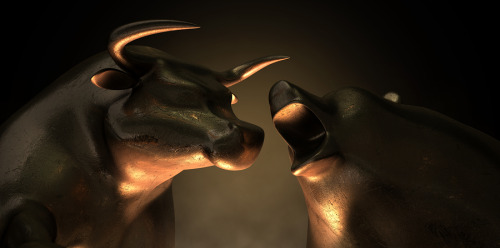http://mitchzacks.tumblr.com/post/140624689918/bears-vs-bulls-who-wins
Mar 07, 2016 at 6:00 AM
Bears vs. Bulls – Who Wins?
Mitch on the Markets
Nope, this is not a Chicago sports piece. It is, however, a review of the storm and stress of the current Bull vs. Bear “conversation” pitting the emotional vs. the rational, the headlines vs. the fundamentals and the reactive vs. the steady.
I’ve written numerous articles addressing the negative and volatile start to the year, so I apologize in advance if you’re tiring of my optimism. My outlook has not changed. Here at Zacks Investment Management, we still think much of the media attention is misplaced and overblown. Additionally, selling pressures will likely be short-lived and, though volatility will almost certainly persist in 2016, I don’t believe the bears have a strong case for a big down year. Lastly, I see the probability of a recession in the U.S. and the world as very low.
My message to investors has been to stay steady and focus on the fundamentals within the U.S. economy and patches worldwide. That message doesn’t change today – I still see stocks as the best place to be in 2016, even if it means accepting subdued single digit returns.
Some data released last week reminded me of an investing tenet I haven’t mentioned in some time: don’t forget to pay attention to data/stories/events that most are ignoring. Over the long-term, stocks typically don’t form bull or bear trends based on what everyone is talking about. In terms of today, this refers to fears over China’s slowdown, falling oil, Fed tightening and a stronger dollar – all factors that probably won’t cause the next bear. It will likely be something entirely different that no one has yet focused on.
On that note, there were three stories that emerged last week that were grossly under-reported, almost certainly due to the media’s preference to keep reporting negative (it attracts more readers and viewers).
Q4 GDP Revised Upward
The Bureau of Economic Analysis announced last week that the U.S. grew at a 1% annualized rate in Q4; markedly higher than the 0.7% previously reported. According to the BEA, growth in Q4 GDP reflected positive contributions from personal consumption expenditures (PCE), residential fixed investment and federal government spending. Those were partly offset by negative contributions from exports (stronger dollar), nonresidential fixed investment, state and local government spending (expected to be solid in 2016) and private inventory investment. This was coming off of 2% GDP growth in Q3. Where’s that recession?
Consumer Spending and Income Improvements
The economy actually got off to a fine start in 2016, which compels me to believe we’re experiencing a correction (where market activity is disconnected from fundamentals). Consumer spending rose at the fastest pace in eight months for January (+0.5%) and personal incomes increased (+0.5%), the largest increase since June.
Inflation Better Than Expected
The Bureau of Labor Statistics reported that the core inflation reading rose at a 1.4% annual rate in January, which is the fastest rate of growth reported in two years. Excluding energy and food, inflation grew at a healthy 2.2%, based on reports signaling price increases in health care and retail - a good sign.
Low or no inflation is a major concern over time – it’s a sign that liquidity and demand have been drained from the economy and it nudges investors to save more, anticipating prices will fall further. In an environment where the Fed is tightening, the last thing you want to see is a string of deflationary readings. Raising interest rates only stands to make it worse. A big factor I think will come into play as 2016 unfolds is the absence of the energy drag on core consumer price index (CPI). As crude prices level off and find a bottom, their downward pressure on inflation should subside as well.
Bottom Line for Investors
Under the heap of negative news stories that accompany volatility, there is a treasure trove of positive, underappreciated economic fundamentals. I’m not saying that the negative can’t outweigh the positive, creating a recessionary or bear market environment – of course that is possible. What I am saying is that often times when we see downside volatility accompanied by worrisome headlines day in and day out, human nature can actually cause us to prefer the negative news to the positive, or just completely ignore the positive all together.
For me what it always comes back to is: are conditions such that a recession is likely in the next 6 – 12 months? In my opinion, the simple answer is “no.” Low likelihood of recession usually means low likelihood of a bear market, a base case for having equity exposure in your portfolio equivalent to your risk tolerance and goals for growth. My recommendation – watch the fundamentals, critically evaluate the headlines and stay steady – your portfolio will likely reward you for it.
 would enable you to enjoy an array of other services such as Member Rankings, User Groups, Own Posts & Profile, Exclusive Research, Live Chat Box etc..
would enable you to enjoy an array of other services such as Member Rankings, User Groups, Own Posts & Profile, Exclusive Research, Live Chat Box etc.. 
 Home
Home


















